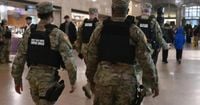On October 16, 2025, a federal judge in Manhattan delivered a decisive blow to the Trump administration’s effort to withhold nearly $34 million in anti-terrorism funding from New York City’s sprawling transit system. In a forceful ruling, Senior U.S. District Judge Lewis A. Kaplan ordered the Department of Homeland Security (DHS) to immediately disperse the funds, declaring the administration’s move “arbitrary, capricious, and a blatant violation of the law,” as reported by multiple outlets including the Associated Press, amNewYork, and Courthouse News.
The money, part of the Federal Emergency Management Agency’s Transit Security Grant Program, was created after the September 11, 2001 terrorist attacks to protect the nation’s mass transit systems from ongoing security threats. For New York City, which suffered the deadliest attack in U.S. history and remains a prime target, these funds are not just a budget line—they are a lifeline. The Metropolitan Transportation Authority (MTA), which operates the city’s subways, buses, commuter rails, bridges, and tunnels, relies on this federal support for targeted counterterrorism patrols, advanced security equipment, infrastructure enhancements, cybersecurity technology, and weapons detection systems.
Judge Kaplan’s ruling, which granted a permanent injunction, follows a turbulent month in which the DHS abruptly slashed the city’s allocation from over $33 million to zero. The federal agency justified its decision by citing New York’s status as a “sanctuary city” for immigrants—a move the judge flatly rejected. In his 28-page opinion, Kaplan wrote, “It did so, it now says, because New York City is a ‘sanctuary city’—not in any respect because it is not a terrorist target.” He continued, “That is money that the MTA needs to help protect the people who every day ride the MTA’s subways, commuter trains and buses and who use its bridges and tunnels against terrorist attacks.”
The court’s decision did not come out of the blue. It was the culmination of a lawsuit filed on September 30, 2025, by the New York State Attorney General’s office after the DHS and FEMA announced the cut. New York officials argued that the funding was being used as a political cudgel to punish the city for its immigration policies, rather than being allocated based on actual security needs—directly contradicting the program’s congressional mandate to distribute funds solely according to terrorism risk.
Governor Kathy Hochul and Attorney General Letitia James, both Democrats, were quick to praise the ruling. In a joint statement, they said, “A court has once again affirmed that this administration cannot punish New York by arbitrarily wiping out critical security resources and defunding law enforcement that keeps riders safe. We will always fight to ensure that New York gets the resources we need to support our law enforcement and keep people safe.” According to amNewYork, they added, “This ruling protecting critical counterterrorism funding is a victory for every New Yorker who rides our subways, buses, and commuter rails.”
New York’s reliance on these funds is not theoretical. The MTA is the largest mass transit provider in the United States, carrying over 6 million daily trips across Metro-North, the Long Island Rail Road, and NYC Transit. As Judge Kaplan noted, “In the decades since, New York City has remained a prime target for terrorist attacks”—and city law enforcement has thwarted at least eight terrorist plots targeting the subways alone since 2001.
The Trump administration’s decision to pull the funding was met with immediate legal resistance. Just a day before the final ruling, a judge had extended a temporary restraining order blocking the cuts until October 22, 2025, giving the court time to consider the merits of the case. The state’s lawsuit highlighted not only the city’s “profound reliance interests in critical anti-terrorism federal funding,” but also the broader stakes for urban transit security nationwide.
The significance of the ruling extends beyond New York. As CBS News reported, the case comes amid lawsuits from other Democratic governors over similar funding cuts, raising questions about the extent to which federal agencies can use financial leverage to influence local policies. The judge’s decision sends a clear message: security funding tied to terrorism risk cannot be wielded as a political weapon.
It’s not the first time in recent weeks that the federal government’s approach to counterterrorism funding in New York has come under scrutiny. On October 3, 2025, the White House reversed DHS’s cut of $187 million in counterterrorism funding for New York’s law enforcement, restoring money that supports intelligence operations, transit hub security, emergency preparedness, and equipment purchases for local agencies. While that reversal was welcomed, the fight over the Transit Security Grant Program underscored the stakes for New York’s day-to-day safety.
The Trump administration, meanwhile, has not publicly commented on the court’s latest order. In July, it filed a separate lawsuit against New York City, Mayor Eric Adams, and top law enforcement officials, arguing that the city’s sanctuary policies are preempted by federal law. That case has since been stayed due to the ongoing federal government shutdown, leaving the dispute over sanctuary city policies unresolved for now.
The legal battle has also played out against a backdrop of heightened political tension. Attorney General Letitia James, who has been at the forefront of the state’s lawsuit, was indicted by federal authorities last week on unrelated bank fraud charges—a development that, while not directly tied to the funding dispute, has added another layer of intrigue to the story.
For New Yorkers who rely on public transit—whether for work, school, or daily life—the restoration of nearly $34 million in anti-terrorism funding is more than a legal victory. It’s a reaffirmation of the city’s right to protect its residents in the face of persistent threats. Judge Kaplan’s ruling, grounded in both the letter of the law and the lived reality of a city shaped by tragedy, makes clear that security cannot be sacrificed for politics.
As the dust settles, the MTA is set to receive its full allocation, ensuring that counterterrorism patrols, modern security technology, and infrastructure upgrades can continue without interruption. The case stands as a reminder that, in matters of public safety, the stakes are always personal—and that the law, at least for now, is on the side of those who ride.

